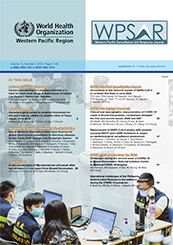Factors contributing to a measles outbreak in a hard-to-reach rural village in Xaisomboun Province, Lao People’s Democratic Republic
DOI:
https://doi.org/10.5365/wpsar.2022.13.3.874Keywords:
measles, disease outbreaks, vaccination coverage, Laos, infectious disease reporting, health literacy, rural healthAbstract
Objective: An increase in measles cases was reported in the northwest of the Lao People’s Democratic Republic beginning in January 2019, with outbreaks quickly spreading throughout the country. Following identification of two laboratory-confirmed cases in Xaisomboun Province, we conducted an outbreak investigation to identify factors contributing to the measles outbreak in hard-to-reach Village X.
Methods: Active case-finding was undertaken at the provincial hospital and primary health care centre via a retrospective search through admission logbooks and house-to-house surveys in Village X and surrounding villages. Clinical samples were collected from suspected cases, and data were collected using a standard case investigation form. Vaccine coverage data were reviewed.
Results: Of the 40 suspected measles cases with rash onset during 12 February–27 April 2019, 83% (33/40) resided in Village X and 98% (39/40) were of Hmong–Lu Mien ethnicity. Ages ranged from 22 days to 5 years, with 70% (28) aged <24 months. Almost half of cases aged 9 to <18 months (5/11) and 67% (8/12) of cases aged >24 months had received a measles-containing vaccine (MCV). Reported MCV coverage in Xaisomboun for children aged <1 year in 2017–2018 was <50%. In 55% (22/40) of cases, case notification was delayed by >6 days. The final case classification comprised 10% laboratory-confirmed, 20% clinically compatible, 60% epidemiologically linked and 10% non-cases.
Discussion: This measles outbreak was likely associated with low immunization coverage, compounded by delays in reporting. Effective strategies are needed to address beliefs about and health literacy barriers to immunization and measles awareness. Such strategies may improve MCV coverage and early diagnosis, enabling timely public health interventions and reducing mortality and morbidity.

